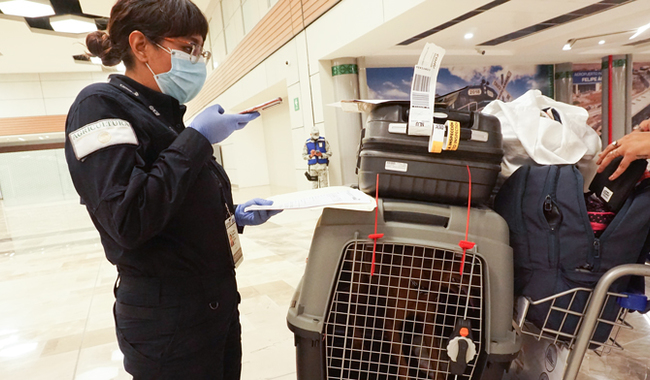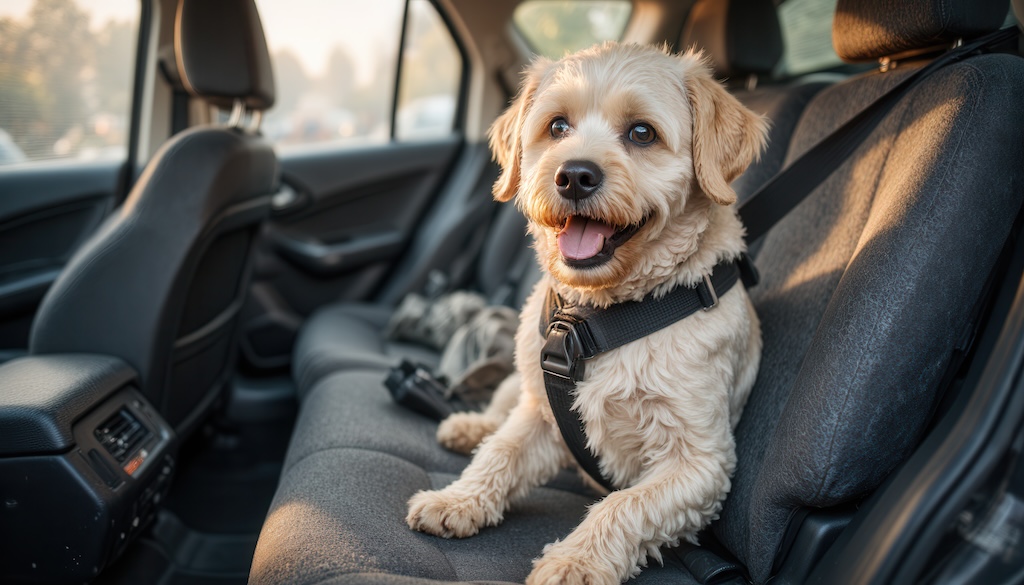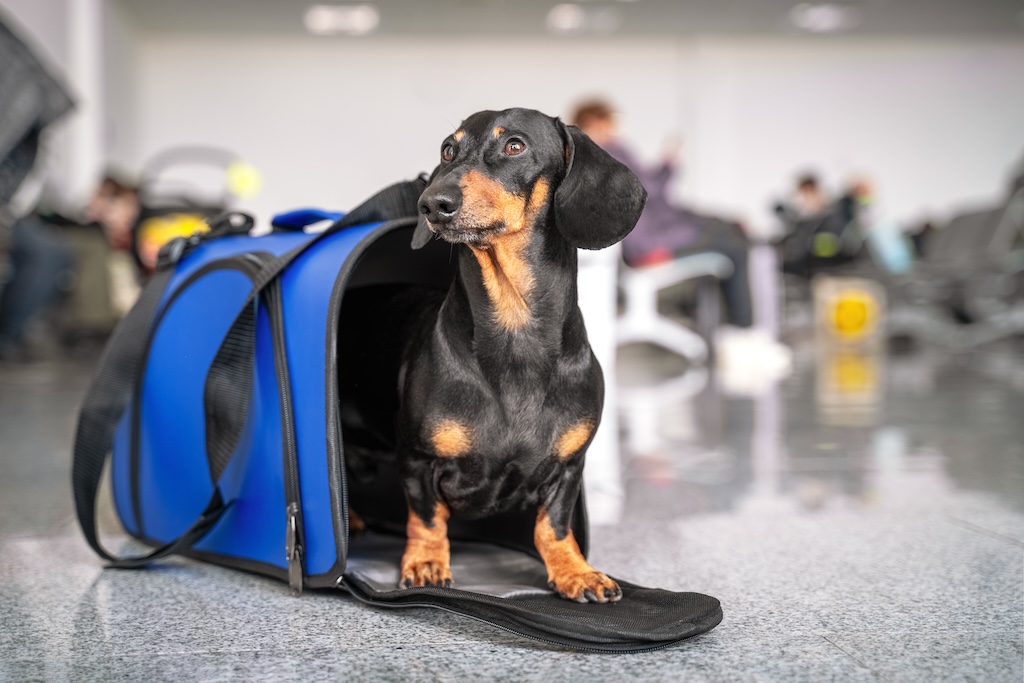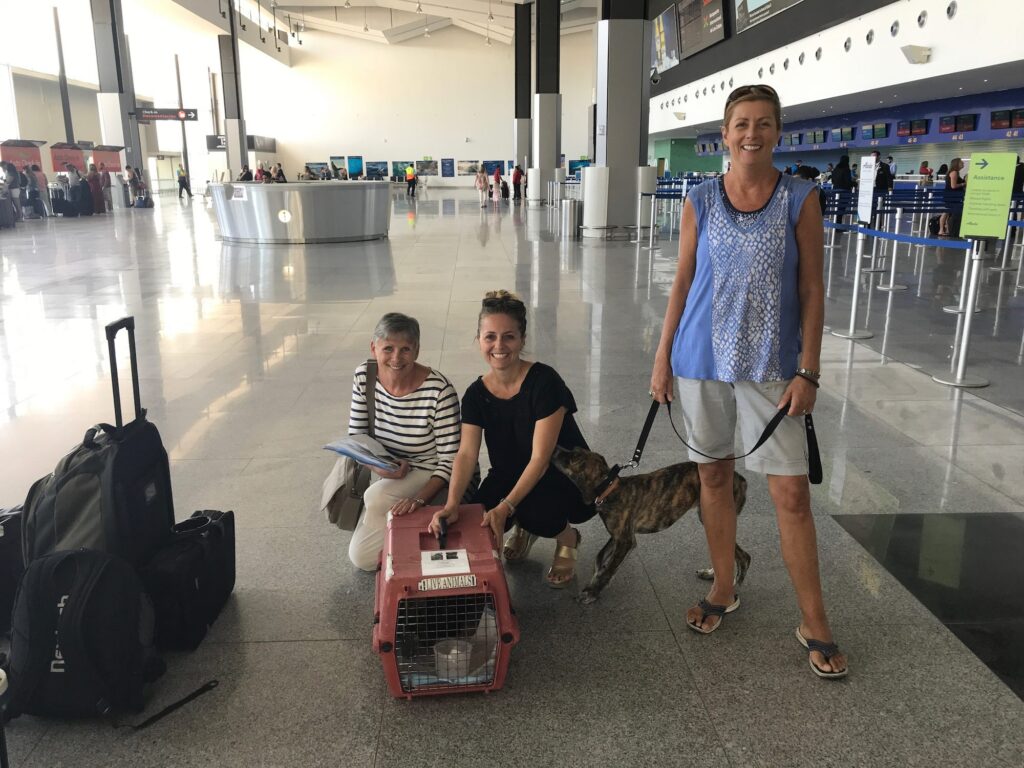How to prepare to bring your pets from the US or Canada into Mexico and back again.
Can you travel to Mexico with your pets? It’s a question we hear a lot from our friends and clients. The answer is yes, in most cases, you can bring your pets with you into Mexico. With the right preparation, traveling to Mexico and back from the US or Canada with your pets is not difficult. However, there are definitely a few things you’ll need to do to prepare for the trip.

With the right preparation, traveling to Mexico and back from the US or Canada with your pets is not difficult.
In addition to helping our clients with their real estate needs, we often rescue and foster dogs here in La Paz for adoption. Part of this process involves sending dogs north to new homes in the US or Canada. We have plenty of experience in doing this, so we are up to date on the requirements for both driving and flying with your pets to and from Mexico. If you are planning on traveling to La Paz (and back) with your pets, following are some key things to keep in mind.
Note: this article covers traveling with domestic pets such as dogs and cats. If you have other types of pets, such as birds, don’t assume you can bring them into Mexico, as the rules may be different. Please visit the web site here for more information: https://www.aphis.usda.gov/pet-travel/us-to-another-country-export/pet-travel-us-mexico
Traveling to Mexico from the US or Canada with Pets
As of 2019, a pet health certificate is no longer legally required to enter Mexico with your dog or cat. This is good news for travelers driving south, as obtaining the health certificates in the US or Canada, especially for multiple pets, can get expensive.
However, please note that, if you are FLYING with your dog or cat, your airline may still require a health certificate and other documentation in order to check your pet in on your flight. Always check with your airline about their requirements, as they may be different from Mexico’s legal requirements.
There is also no legal requirement to present proof of a rabies vaccine or vaccination records when entering Mexico. However, we strongly encourage you to bring these records with you when you travel, as it can help speed the process if you are asked about your pets and to prove ownership.
Is Mexico a Rabies Free Country?
You may hear that Mexico is a “rabies-free country,” and that is true. In 2019, Mexico became the first country in the world to receive validation from the World Health Organization (WHO) for eliminating dog-transmitted rabies as a public health problem. It is not necessary to show proof of a rabies vaccine to enter Mexico. However, it is required to enter the US from Mexico, so you will need this proof of rabies vaccine documentation on your return to the US.
Legally, your pets are subject to a physical inspection at the border by a Mexican government official (SENASICA). This rarely happens if you are driving across the border, but may happen when you arrive with your pet at a Mexican airport. More details are available here.

Legally, your pets are subject to a physical inspection at the border by a Mexican government official (SENASICA).
Pet Appears Healthy: Your pet must appear healthy, with no visible signs of sickness or open wounds, and also be free of ticks and other ectoparasites. Your pet may be subject to inspection by a government official at the border or, if flying, when you land in Mexico, and can be turned back, held or quarantined if it’s determined the pet is not healthy or needs treatment for parasites.
If you are driving: it is required that your dog be secured in a crate or attached by a harness to the seatbelt or otherwise restrained when you are entering Mexico. This is most often enforced at the border, and sometimes at military checkpoints, so it’s a good idea to make sure your pet is restrained when crossing by car into Mexico. Once you are on the road and away from the border, your pet can enjoy more freedom in your car, but keep in mind restraining your pet in your car is always a good idea for safety reasons.

Dogs must be restrained in a crate or harness attached to a seat belt when entering Mexico.
Traveling to Canada from Mexico with pets
Flying into Canada with your pet is much simpler than flying into the US. The requirements are only:
- Age appropriate vaccines
- A current rabies vaccine
- Dog must appear healthy, free of parasites, etc.
Again, different airlines may require different documentation, so always check with your airline first to make sure you meet their requirements. Also, if you are driving north to Canada, you will still need to meet the US requirements to enter the US with your pet. It is worth noting that Canada does have additional requirements for pets that are not your own. For example, if you are flying with a rescue pet that is going to a new home in Canada, their may be additional import requirements. Check this web site for more details.
Traveling to the US from Mexico with pets
Here’s where things get a bit more complicated. It’s not difficult for dogs and cats to travel north to the US from Mexico, but you do have to comply with certain paperwork requirements. If you are driving, chances are you will not be asked for paperwork at the border, but it can and does happen occasionally so it’s best to be prepared.
To travel into the US with a dog you must have:
- Age requirement: All dogs and puppies must be at least 6 months of age to enter the US from Mexico. There is no age requirement for cats.
- An international (ISO Compliant) microchip: This is a 15-digit microchip containing only numbers that operates at a frequency of 134.2kHz. These are different than some of the older microchips issued in the US, so check to be sure your pet has an ISO compliant chip. The microchips come with several stickers, it’s a good idea to put the microchip sticker on the CDC Import form, and on the health certificate and in their carnet.
- CDC Dog Import form: The CDC requires that you fill this form out online and then they email you the receipt to print out. The receipt is auto-generated and you’ll receive the email within a few minutes of submitting the form. You can fill it out here: https://www.cdc.gov/importation/dogs/dog-import-form-instructions.html. The receipt is good for multiple entries for up to 6 months. Not needed for cats.
- Screwworm certificate: This is a more recent requirement for dogs only (not cats), based on the news that the screwworm parasite, which had previously been eradicated in the US and Mexico, was recently found present in some cows in Mexico. The vet issuing the Screwworm certificate must be certified by the Mexican government to issue it, and as of this writing, not all vets in La Paz are certified. Be sure to ask your vet if he or she is able to issue the certificate. Some vets in La Paz that we know are certified to issue screwworm certificates are Bayliss Veterinaria on Colima, and Mario’s Clínica Veterinaria El Centenario in El Centenario. You can see a full list of vets certified to issue screwworm certificates here: https://shorturl.at/DsMAe.
The following are not legally required to enter the US, but may be required by your airline, and in our experience it’s best to have these to present at check-in if you are flying with your pet to the US from Mexico:
- Vaccination Record: The dog’s vaccine card/health record with the appropriate vaccines for their age.
- Proof of Rabies Vaccine: A rabies vaccine or booster that was given more than 30 days before your travel date and after the ISO microchip was implanted. So if you are traveling on November 15th, your pet’s rabies vaccine or booster must be dated October 14th or earlier, and the microchip should be applied before the vaccine is given. If your dog was given an annual rabies booster in the US, that satisfies the requirement as long as it’s not expired. You should have the sticker from the vaccine with the date in your dog’s vaccine record.
- Health Certificate: If you are flying, you will most likely also be required to present a health certificate from a licensed vet stating the dog is free of fleas and ticks and disease, and that includes the rabies vaccine information. This should be dated within 5 days of your travel.
Again, if you are driving across, it’s possible they will not check any of this paperwork at the border, but it’s a good idea to have it just in case. If you are flying with your pet, it’s important that you have all of the above, as the agent will review all of this when you check in for your flight.
Flying with Your Pet
In addition to the above documentation, check your airline’s website for specific instructions on traveling with pets. Some require additional documentation such as proof of rabies vaccine and health certificates, in addition to the CDC Import form. Also don’t assume your airline allows you to book a pet on your flight. Alaska Airlines, Westjet, and Volaris do. Delta and Southwest, among others, do not.
You must contact the airline to reserve a spot on the flight for the dog, whether it is flying in cabin with you or in cargo. There is an extra fee, typically anywhere from $75 to $150 USD, depending on the airline, to fly with your pet, paid at the time of check-in. If flying in cabin, your dog’s carrier must be small enough to fit under the seat in front of you, so only cats and small dogs are typically allowed in cabin. Larger pets (except for service animals) must fly in the cargo hold.
Breed Restrictions: The airlines that do allow pets to fly often have restrictions on specific breeds, especially short-nosed breeds that may have breathing problems during flight. Check with your airline’s web site to be sure your pet is allowed to fly.
Airline Approved Crate: You will need an airline crate big enough that allows the dog to stand up without it’s head touching the top of the crate and turn around freely. If your pet is flying in cabin, this can be a soft sided carrier, if you are checking your pet in cargo, you’ll need an airline approved plastic crate.

Be sure to check with your airline for their specific requirements for flying your pet.
On your Travel Date
You must arrive at the airport 2+ hours before your flight to check in your pet. It’s best not to feed the pet the morning of travel as they can get sick and vomit in their crate from motion sickness. Giving water is fine.
Do not give your dogs any drugs to calm them, if the airline agent thinks the dog is drugged they may refuse to let it fly. Also, many of these drugs can make your pet nauseous, so it’s better not to give them.
Once you check in at the counter with your pet, the agent will check your documentation and visually check your pet. They may also weigh your pet in its crate to make sure it doesn’t exceed the limit. If your pet is traveling in the cargo hold, the agent will usually let you go walk your dog outside for a bit, and ask you to come back to the counter an hour before your flight with your pet.
An hour before your flight, you will take your dog back to the counter and they will zip tie and tape the crate closed and put Live Animal stickers on it. You can put a towel on the floor of the crate and we often put down pee pads as well under the towel. You should take your pet’s leash off (collars are ok to leave on) and bring it with you. Do not put toys, stuffed animals, or other items in the crate. Most airlines do not want you to put food or water in the crate either, so make sure your pet drinks water the morning of your flight. No food though, as they are more likely to vomit during transport on a full belly. Your pet will be sent through the baggage conveyor to the baggage area and you will proceed through security to your gate. Some airlines, like Alaska Air, will bring you a receipt once you are in your seat to let you know your pet has been safely loaded on board in the cargo hold.
Once you land at your destination, in the US you should present the documentation for your dog to the customs agent before you leave the customs and immigration area. Once your dog is approved, they will bring your dog’s crate out, usually to the oversized baggage area, and you are free to go. If someone is meeting you at the airport, have them bring some scissors, paper towels, etc with them. If you want to take your dog out of the crate you will need to cut the zip ties and tape to open the crate door.
Be sure to ask where your pet will be delivered in the baggage claim area. For example, if you are flying into Seattle airport, you will arrive in the international terminal, but your pet may be brought out in the baggage area at the main terminal. Ask an agent when you land where your pet will be brought out.

Flight angels can volunteer to escort rescued dogs to their new homes on their flight north. A volunteer meets you at the airport to check the dog in and takes care of all paperwork.
What Are Flight Angels?
We want to give a special shout-out to flight angels or pet escorts. These are people who are visiting Baja and who volunteer to escort a rescue pet north on their flight to their new adopted home in the US or Canada. Rescue organizations rely heavily on these volunteers to get rescued dogs and cats to their new homes! It is a very easy thing to do: a volunteer meets you at the airport for your departure with all the required paperwork, pays the fee for the pet to fly, and checks the pet in for you. When you arrive at your destination, a volunteer and/or the adopter meets you at the airport to receive the dog. There is no cost to you and minimal effort on your part. All you have to do is say yes and you will help a rescued dog or cat get to its new home! Please consider volunteering to be a flight angel, rescuers literally could not do their work without this vital service! To volunteer as a flight angel, contact a local rescue organization or you can join the the Los Cabos Pet Escorts Facebook group here to volunteer.
Travel Checklist:
We understand this sounds like a lot of information, so we’ve consolidated it here into a simple checklist you can use for reference.
Entering Mexico from the US or Canada:
- Pet appears healthy
- Pet needs to be restrained in a crate or attached to a seatbelt (if driving)
- Current vaccination records are recommended but not required
- Pets may be subject to physical inspection upon arrival in Mexico
Entering Canada from Mexico:
- Current rabies vaccine (if pet is 3+ months old)
- Pet appears healthy
- Proof of ownership (or commercial import license if you are a rescue organization)
- May need a health certificate from your vet in Mexico
Entering the US from Mexico
- Puppies must be at least 6 months of age
- CDC Dog Import Form receipt (fill out the form online here). Good for 6 months/multiple entries. Not necessary for cats.
- ISO Compliant Microchip (put the stickers on your pet’s travel docs)
- Screwworm Certificate from a certified vet given within 5 days of travel. Not required for cats. Vets certified for screwworm exam can be found here.
Recommended additional paperwork (may be required by your airline):
- Vaccine records with proof of rabies vaccine or booster dated 30+ days before travel
- Health Certificate dated within 5 days of travel. (Get this at the same time you get your screwworm certificate).
- Copy of your Mexican vet’s license
